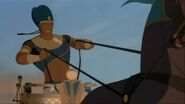- “'I have to maintain the ancient traditions; I bear the weight of my father's crown.'”
- ―Rameses
Rameses II (c.1303 BC-1213 BC) is the main antagonist (formerly a supporting protagonist) of the 1998 film The Prince of Egypt, the secondary villains being Hotep & Huy and his father Pharaoh Seti I despite the latter not being seen. He is based on the Pharoah from the Biblical tale of Moses; indeed, the movie, for the most part, follows the story faithfully. However, in The Prince of Egypt, he and Moses were raised as brothers and the conflict between them is seen as a deeply personal one on both sides.
Personality
While it would be an exaggeration to call him a tragic villain, Rameses was not truly evil per se; just stubborn. His cruelty and stubbornness apparently stems from his past, where his father taught him to hold fast to a strong will, and an unwavering mindset; it is worth noting that Rameses' principal objective was getting his father's acceptance. Rameses also did genuinely and deeply care about his son, and was utterly broken by his son's death.
At the start of the movie, Rameses did have a true brotherly bond with Moses, and they considered each other quite close. You could also consider him to be a control freak, forcing high standards on one of his guards, and bringing a guard who is ill up onto his feet and giving him his stick even though he is too ill to guard his king.
Role in Film
Childhood & Early Rise To Power
Rameses was but a toddler when an infant Moses was discovered by his mother; during this period in history, his father had ordered the death of all Hebrew boys after a prophecy saying that the slaves would be united under a leader chosen by God (similar to how Herod would, many years later, attempt another Massacre Of The Innocents). The young Rameses was by his mother's side as she took his new baby brother to meet the Pharoah. The Pharoah agreed to raise the infant, and Rameses presumably shared a happy childhood with Moses, accepting him as his own brother.
When we next meet them, Rameses and Moses are in their early teens and prone to mischief, engage in wild chariot races. Both brothers were competitive but fairly good-natured towards one another; however, their chariot race caused great damage to their surroundings, infuriating Rameses' father who was harsh with his eldest son, calling him a "weak link," and insult that deeply wounded Rameses and would continue to affect him later in life.
However, a short time later, Rameses was appointed Prince Regent by his father (who was moved by an appeal with Moses on his brother's behalf), and he promptly appointed Moses as Royal Chief Architect. During the celebrations, Hotep & Huy were ordered to give Rameses a gift as a sign of respect for their new superior, and the two high priests offered Rameses a kidnapped women from a desert tribe as his bride (or more likely, a concubine). However, due to her fiery nature, Rameses didn't want her and tried to give her to Moses, which simply angered her more and she fought back until she was humiliated by Moses; Rameses found this amusing and ordered the guards to "dry her up and have her delivered to Prince Moses' chambers" (although Moses ultimately set her free).
At a later point, Rameses was overseeing the building of a great temple when Moses (who had recently learned of his true Hebrew heritage) fought against a guard abusing an old slave and accidentally killed him in the process. Rameses was shocked and confused, and ran after his brother as he fled; he showed little concern over the death of the guard and even told Moses that, as royalty, he could see to it that the crime would never be heard of again. However, Moses was too full of regret and confusion and fled into the desert, leaving Rameses alone in Egypt.
Taking the Throne
During Moses' time in the desert, Rameses has taken power following the death of his father, and the oppression of the Hebrews has become worse as Rameses continued to build, determined to make a legacy as great as that of his father. When Moses returned, Rameses was overjoyed. Hotep and Huy were quick to try and ruin the reunion, however, by insisting Rameses enforce the death sentence on Moses for killing the guard; however, Rameses dismissed them and proclaimed Moses innocent of all crimes and a prince of Egypt. Unfortunately for Rameses, Moses was charged by God to stand against Rameses and free the Hebrews, which would quickly cause the two brothers into a confrontation.
Conflict With Moses
When Moses transformed his staff into a cobra as his first miracle, Rameses was unimpressed and had Hotep and Huy perform a magic act of their own in order to try and humiliate Moses. Following this event, he motioned to Moses to follow him in a secluded area so as to talk alone. Once Rameses was away from the public eye, he conserved more openly with Moses, trying to justify not only his own actions but that of his father. However, he was visibly hurt when Moses rejected his words, then grew angry and told Moses that he "knew not this God," that he would not let the Hebrews to be free and that he would not be the weak link. Rameses then informed Moses that all slaves would have their workload doubled, implicitly blaming Moses.
When the two next met, Rameses was enjoying a boat ride on the Nile when Moses once again demanded that he "set his people free." Rameses grew tired of Moses and ordered his guards to bring Moses to him. His guards attempted to capture Moses, only for God to turn the Nile River into blood as another of His miracles. At first, Rameses was shocked at this show of power and demanded that Hotep and Huy explain how it was done. When the two magicians replicated the miracle via the use of dye. Rameses' fear subsided and he laughed it off, then warned Moses that the "joke" must now end, unaware that this was just the beginning of God's wrath.
The Plagues
The two brothers' confrontation reached its climax during the event known as the Ten Plagues of Egypt, in which God unleashed His greatest curses upon the kingdom of Egypt. Although the suffering was unbearable, Rameses refused to give into Moses' demands; as a result, the people of Egypt suffered for many days and nights as the wrath of God manifested as frogs, flies, death of livestock, fire from the sky, painful boils, locusts and darkness.
During the onset of the great darkness, Rameses was visiting by Moses in the temple. He was embittered and angry, paralleling his father when he expressed a desire to re-create the events of the massacre (stating that his father may have had the right idea about dealing with the Hebrews); this saddened Moses, who told Rameses that he had brought the final plague upon himself. Thus, due to Rameses' hubris, the Tenth Plague was unleashed upon Egypt and all of the kingdom's firstborn children died, including Rameses' own son.
Overwhelmed with grief, Rameses told Moses to go and take his people with him; thus the Hebrews (along with some Egyptians) left Egypt behind and began their great exodus.
Final Confrontation
However, Rameses had a change of heart and pursued the Hebrews across the desert, cornering them at the Red Sea alongside a small army. He charged at them with the intent of either recapturing them or killing them; however, God intervened by sending a pillar of flame to stop Rameses and his army long enough for Moses to part the Red Sea using his staff. The Hebrews then proceeded to cross the sea.
However, Rameses wouldn't stop and, once God removed the pillar of flame, he resumed his charge, prompting God to close the path made by Moses, drowning many of Rameses' men and sending Rameses himself hurling back onto the shore and later died. Moses thought of him yelling "MOSES!" before Moses left.
Gallery
Trivia
- Rameses is played by Ralph Fiennes who also played Lord Voldemort (the primary antagonist of the Harry Potter series) and M in the James Bond series. He also voiced Jesus in the "The Miracle Maker" and Hades god of the Underworld in Clash of the Titans and Wrath of the Titans.
- Ralph Fiennes's brother Joseph Fiennes later voiced Proteus, also a prince, in another DreamWorks animated feature Sinbad: Legend of the Seven Seas.
- Ralph Fiennes would also voice Lord Victor Quartermaine in Wallace & Gromit: The Curse of the Were-Rabbit.
- Historically, the real Ramesses II is known being close to if not the greatest builder among the Pharaohs and had extensive building projects throughout Egypt and Nubia. This is shown in the movie by Rameses's ambition and enthusiasm in his new role as Prince Regent to rebuilt the temple he and Moses destroyed. He had also built monuments of himself later on as Pharaoh that were shown being damaged by the plagues later on in the movie.
- Ramses II had 200 wives, 96 sons, and 60 daughters. By the time he was Pharaoh he had 20 children. In the film only one son is seen and none of his wives or daughters are there (However there is a women standing next to Ramses's throne possibly Nefretari.)
- Ramses II was around 25 when he became Pharaoh and 95 when he died. He was preceded by his 13th son Merneptah who actually wrote about how the Hebrews conquered Canaan.
- In the film Ramses goes through three different ages he is first seen as a two year old. Then he is seen as a 20 year old. In the end he is at least 30 but could be 50.
- In the original script Ramses was gonna have a pet cat on par with Moses and his two dogs.
Template:Villains




